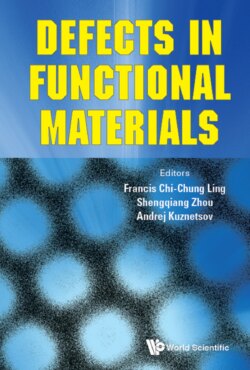Читать книгу Defects in Functional Materials - Группа авторов - Страница 10
3. Optical Characterization
ОглавлениеThere are many techniques used to characterize the materials optical properties, as reviewed for example by Davies [20], Dragoman and Dragoman [21], Schroder [6], and Grundmann [8]. These methods include studying the luminescence, optical absorption, and inelastic Raman scattering, etc. Configuration coordinate diagram of defect can be used to understand the processes of luminescence, light absorption and nonradiative capture, as reviewed by Alkauskas et al. [22].
Figure 3. (a) The electron hole pair generation; and (b–e) transitions that could lead to photon emissions.
In particular, the luminescence spectroscopy in forms of either photoluminescence (PL) or cathodoluminescence (CL), is widely employed method to identify optical active defects. A laser with photon energy larger than the material band gap is usually employed to excite electrons from valance band to conduction band for PL, while the excitation in CL is achieved via the accelerated electrons (Fig. 3(a)). The depth resolved CL can also be carried out to obtain the defect depth profiles by varying the electron incident energy while keeping the excitation power constant [23, 24], while the depth information of electron energy loss can be obtained from the Monte Carlo simulations [25].
Characteristic “defect emission” occurs as a result of the electron transitions from the conduction band to the defect level, or from the defect level to the valance band (Figs. 3(c) and (d)), so that the photon energy emitted can be assigned to a specific defect [26]. Otherwise, the donor-acceptor pair (DAP) emission is originated from the recombination between an electron of a neutral donor and a hole of a neutral acceptor (Fig. 3(e)) and the emitted photon energy is:
where Eg is the band gap, while R is the distance between the donor and acceptor, ED and EA are the donor and acceptor energy levels, respectively. Free recombination between free electrons and holes yields photons with energy equal to the band gap. However, due to the Columbic attraction, an electron at the conduction band and a hole at the valance band can also form a hydrogen like state called free exciton. The photon energy emitted from the free exciton recombination is:
where EX is the exciton binding energy. For materials with low exciton binding energy (like GaAs, EX ∼ 4.2 meV), free exciton emission is only observed at low temperatures. For materials having large exciton binding energy (like ZnO, EX ∼ 60 meV), free exciton emission is observed at the room temperature. Excitons can be bound to donors, acceptors or other potential fluctuations. For example, the transition energy for the donor bound exciton (D0X) is given by:
where Q is the binding energy of the exciton to the donor.
